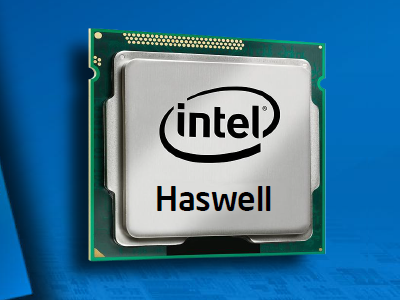Intel's Haswell Reaches a Low 4.5 Watts SDP
Intel confirmed on Tuesday that a new fourth-generation Core processor will be available operating at as low as 4.5 watts SDP, or scenario design power, in addition to the 6 watt versions. Both chips will be available in the second half of 2013, and allow device makers to produce the first fanless 2-in-1 and tablet designs based on Core processors.
Back in September 2012, the company said that it had reduced the platform idle power of its fourth-generation Core "Haswell" processors by more than 20 times over the second-generation CPUs while delivering outstanding performance and responsiveness. The company also promised a new line of Haswell chips with even lower thermal envelopes based on the same microarchitecture in 2013.
"To spur even more innovation in mobile computing, Intel's new low-power chips based on 'Haswell' microarchitecture will broaden the company's mobile roadmap, initially operating at about 10 watts to enable thinner, lighter Ultrabook, convertible and tablet designs with better performance and battery life," the company said.
Then in early June, Intel launched the Core "Haswell" family. At the time, the company said it had exceeded its expectations on power reduction at the CPU level to as low as 6 watts and also worked across the system for power optimization. Active power was improved as was idle power by architecting new ultra low-power processor states where the CPU consumes a fraction of the power compared to previous idle states, the company said.
Now with a 4.5 watt Haswell chip in sight, consumers will see thinner, lighter laptops and hybrids (convertibles, laptops-tablets, whatever) because manufacturers may not need to compensate for CPU fans. The need for CPU cooling will likely rely on the device's overall focus: Will the consumer need a high-performance product, or a solution for word processing, Internet browsing and forum trolling? Whatever the case, fanless seems to be on the immediate horizon.
So far it's unclear whether tablet makers will use the low-power Haswell chip in their designs. Upcoming Windows-based tablets are expected to utilize the "Bay Trail" platform for Atom SoCs, but they won't deliver the performance of Intel's mainstream Core Haswell processors. That said, the low-power Haswell solution will likely reside in pricey, performance-driven solutions, whereas the Atom chip will drive cheaper, light-weight mainstream devices.
It will be interesting to see how the Atom and low-power Haswell chips play together in the mobile and laptops sectors. Look for the low-power Haswell chips to arrive later this year.
Get Tom's Hardware's best news and in-depth reviews, straight to your inbox.

Kevin Parrish has over a decade of experience as a writer, editor, and product tester. His work focused on computer hardware, networking equipment, smartphones, tablets, gaming consoles, and other internet-connected devices. His work has appeared in Tom's Hardware, Tom's Guide, Maximum PC, Digital Trends, Android Authority, How-To Geek, Lifewire, and others.
-
expl0itfinder I cant wait to see the day in which Intel Extreme Edition processing power will be available in such a low TDP. On a mobile platform. Technology amazes me.Reply -
dragonsqrrl Reply11221789 said:What is "SDP"?
It's Intel's measurement of average heat output under typical tablet workloads. If you run something like prime95 or furmark on this platform with no thermal management (which is unlikely to happen), it'll probably hit it's full 11.5W TDP. -
dragonsqrrl Reply11221731 said:Interesting because on my desk top my Ivy bridge is running at 10 watts...
Interesting, which desktop Ivy Bridge processor is that? The lowest TDP Ivy Bridge SKU I'm aware of has a TDP of ~17W, and that's not a desktop part.
And in any case it wouldn't be the same. For ULV Haswell Intel worked a lot on not only CPU/GPU thermal management, but total platform thermal management as well. The PCH is now integrated on package, so that 4.5W SDP (11.5W TDP) is for the CPU, GPU, PCIe bus, memory controller, and south bridge.
Edit: The Pentium 2129Y has a 10W TDP, but again not a desktop processor. -
Augray37 Reply11222032 said:11221731 said:Interesting because on my desk top my Ivy bridge is running at 10 watts...
Interesting, which desktop Ivy Bridge processor is that? The lowest TDP Ivy Bridge SKU I'm aware of has a TDP of ~17W, and that's not a desktop part.
And in any case it wouldn't be the same. For ULV Haswell Intel worked a lot on not only CPU/GPU thermal management, but total platform thermal management as well. The PCH is now integrated on package, so that 4.5W SDP (11.5W TDP) is for the CPU, GPU, PCIe bus, memory controller, and south bridge.
Edit: The Pentium 2129Y has a 10W TDP, but again not a desktop processor.
yeah i think he's talking about 10W at idle. -
JPNpower My desktop CPU uses less power at idle than this does at full load.Reply
My desktop CPU is far faster though and is based on larger transistors, and bigger is better. It also is just flat out better.
Sound stupid? Its how most advertising works actually. -
dragonsqrrl Reply11222195 said:Maybe 10W while idle, surely not during max load.
It makes very little sense to me for someone to say that without further context, in response to an article that discusses SDP and gives no figures for power consumption at idle... but you're probably right.
